Phone: (585) 902 2822
Email: info@jimmysuits.com
Tailored Elegance, Timeless Confidence.
Tailored Elegance, Timeless Confidence.
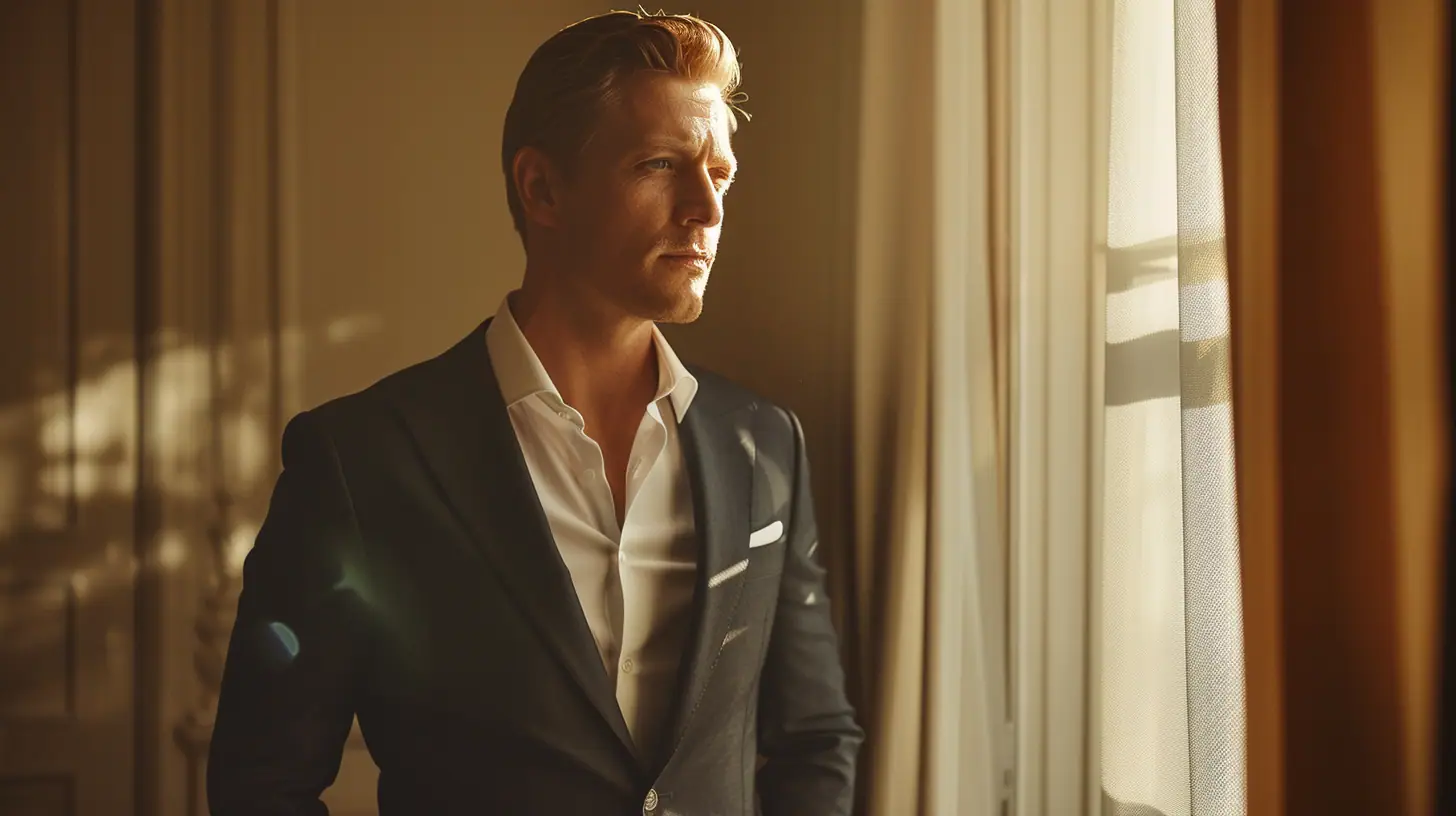
A suit makes you look good because it’s designed to enhance your natural masculine features while concealing imperfections. The structured shoulders create a commanding V-shaped silhouette, while proper tailoring emphasizes your best proportions and improves posture. You’ll notice that suits use strategic color psychology and fabric draping to convey power, success, and trustworthiness. The symmetrical design and vertical lines naturally draw the eye upward, making you appear taller and more confident. Whether it’s navy blue for authority or charcoal for sophistication, there’s more to the magic of a well-fitted suit than meets the eye.
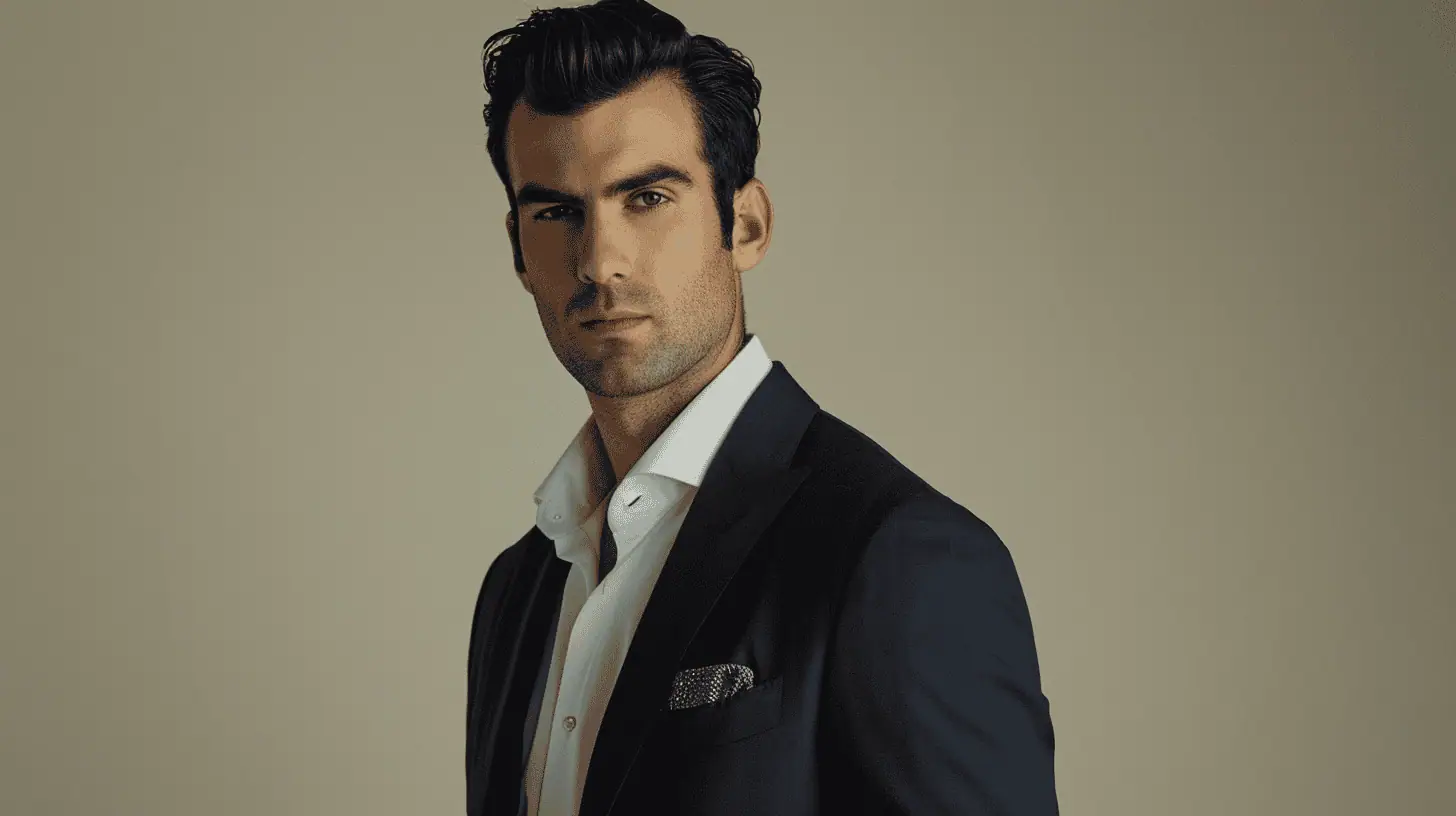
A suit’s structured shoulders create an imposing silhouette that instantly enhances a man’s physical presence. When you put on a well-tailored suit jacket, you’ll notice how the shoulders broaden your frame and create a more commanding appearance. This isn’t just about aesthetics – it’s about how the structured silhouette affects both your self-perception and how others perceive you.
The magic lies in the suit jacket’s construction. Traditional shoulder pads, carefully positioned between the outer fabric and lining, create a clean, horizontal line from your neck to your arms. This structured design smooths out any natural unevenness in your shoulders and helps the jacket drape properly across your chest.
You’ll find that this architectural element makes your torso appear more proportional, regardless of your body type.
What’s particularly effective about structured shoulders is how they mirror the idealized male form. They create the sought-after V-shaped torso by making your shoulders appear broader in relation to your waist. Even if you don’t have the physique of an athlete, the suit’s shoulders will give you that stronger, more athletic appearance.
The shoulder construction also helps improve your posture. When you’re wearing a jacket with proper shoulder structure, you’re more likely to stand straighter and pull your shoulders back.
This improved posture, combined with the visual enhancement of the shoulder pads, creates a more confident, capable appearance that’s particularly valuable in professional and formal settings.
The art of looking good in a suit relies heavily on achieving proper visual balance throughout the entire outfit. When you understand balanced proportions and body awareness, you’ll create an ensemble that enhances your natural features while minimizing any asymmetries. Visual symmetry plays an essential role in how others perceive your overall appearance, and a well-fitted suit helps achieve this balance naturally.
Your outfit coordination should focus on creating aesthetic appeal through thoughtful color contrast and accessory integration. A properly balanced suit creates harmony between your upper and lower body, ensuring that neither portion dominates the overall look.
You’ll want to take into account these key elements for best style versatility:
When you’re mindful of these principles, you’ll notice how each element works together to create a complete picture. The suit jacket’s cut should complement your shoulder width while tapering appropriately at the waist, creating a balanced silhouette.
Your trousers should maintain proper proportions with the jacket, ensuring the length and break hit at the right spots. Remember that visual balance isn’t about perfect symmetry – it’s about creating harmony between all elements of your suit to enhance your natural features.
Building upon proper visual balance, vertical lines in a suit greatly impact your perceived height and stature. When you’re wearing a well-tailored suit, the vertical lines created by the seams, lapels, and trouser creases work together to create tall impressions. You’ll notice that these lines naturally draw the eye upward, creating a lengthened appearance that makes you look taller and more commanding.
| Design Element | Height Enhancement Effect |
| Pinstripes | Creates unbroken vertical flow |
| Lapel lines | Draws eyes upward naturally |
| Trouser crease | Extends leg line appearance |
| Center button stance | Maintains vertical continuity |
The strategic placement of these vertical elements isn’t just about making you look taller – it’s about creating a more authoritative presence. You’ll find that a suit’s vertical lines work particularly well when they’re uninterrupted, which is why you should avoid wearing belts that contrast sharply with your suit color. When your suit jacket’s buttons align properly with your body’s midline, they reinforce the vertical flow from your shoulders to your feet.
To maximize the height-enhancing effects of your suit’s vertical lines, you’ll want to guarantee your jacket length hits at the right point – typically at the middle of your palm when your arms are at rest. This proportion maintains the vertical flow while creating a balanced silhouette. Remember that even subtle details like the break in your trousers can affect how these vertical lines work in your favor.
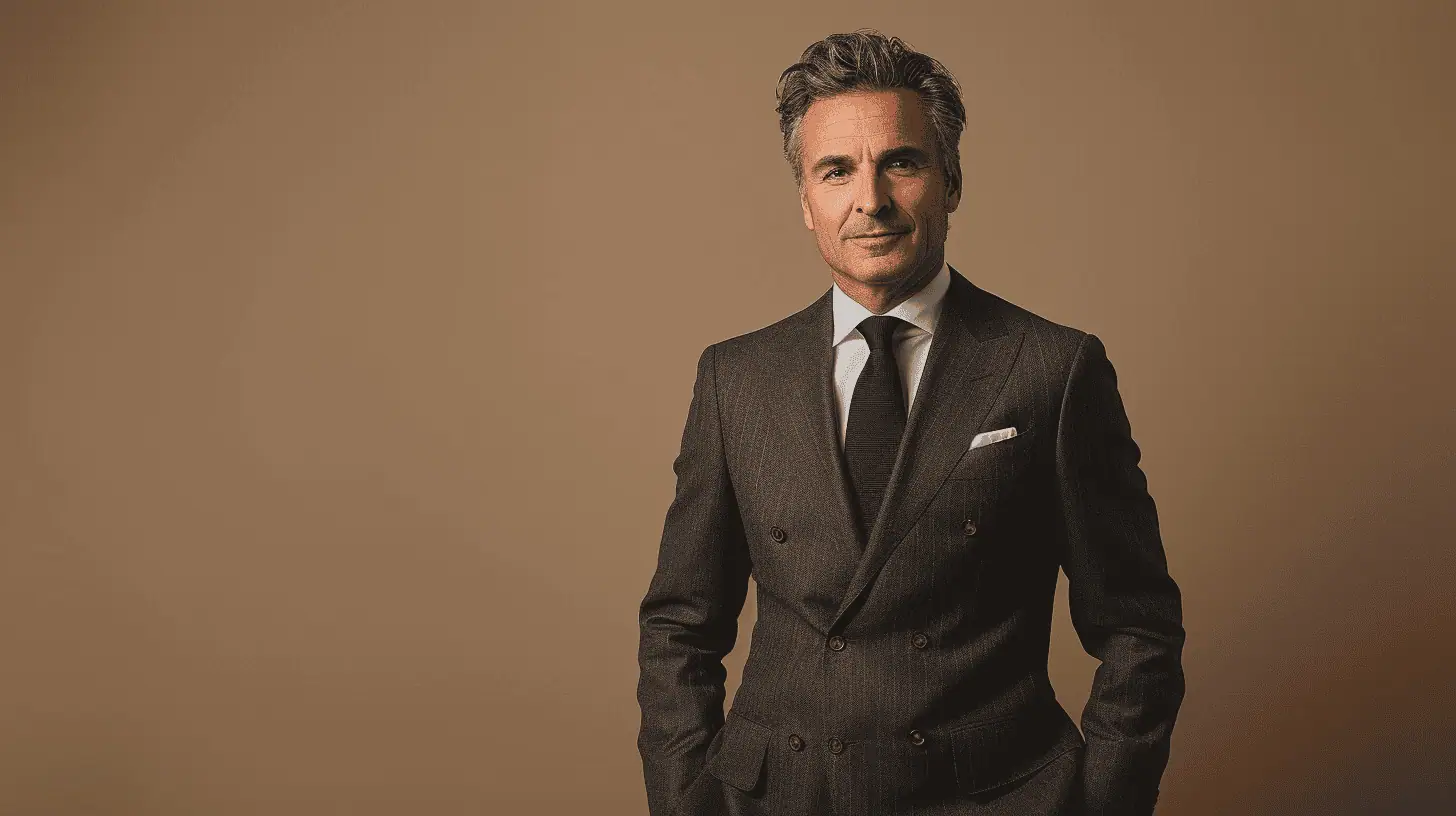
Color selection in formal wear goes far beyond mere aesthetics, tapping into deeply rooted psychological responses that affect how others perceive you. When you’re choosing a suit, understanding color psychology helps you harness both emotional responses and cultural meanings to your advantage.
Navy blue conveys trustworthiness and authority, while charcoal grey projects sophistication and professionalism. Black, though classic, can appear severe in certain contexts.
Your suit’s color creates immediate impressions through established color associations. You’ll want to reflect on these key factors when selecting your suit’s color palette:
Personal preferences should align with your professional goals while respecting these psychological principles. If you’re aiming to appear approachable, contemplate warmer browns or medium blues. For negotiations or leadership roles, deeper blues and greys can reinforce your authority.
The key is balancing these elements with your natural coloring and the message you want to convey.
Remember that color psychology isn’t just about the suit itself – it extends to your shirt, tie, and accessories. These elements work together to create a cohesive impression that either enhances or diminishes your intended impact.
Beyond selecting the right colors, mastering proportion guarantees your suit enhances rather than fights against your natural body shape. Understanding how different suit styles interact with various body types allows you to make informed choices that maximize your appearance and boost your body confidence.
For a lean build, you’ll want to create visual effects that add structure and width. Double-breasted suits and peaked lapels can broaden your shoulders, while horizontal patterns add perceived mass.
If you’re carrying extra weight, single-breasted suits with vertical pinstripes create a lengthening effect, and structured shoulders balance your silhouette shapes.
Fit variations play a vital role in achieving the ideal proportion. Your jacket should contour your torso without pulling at the buttons, while trousers should follow your leg line without excess fabric.
Despite changing fashion trends, certain principles remain constant: shoulders should align with your natural shoulder edge, and jacket length should cover your seat.
Style evolution has introduced multiple cuts, from classic to slim-fit, but don’t let trends override what works for your frame. Athletic builds benefit from modern tailored fits that showcase broad shoulders while tapering at the waist.
Shorter men should opt for suits with higher button stances and shorter jackets to elongate their appearance. Taller men can experiment with longer jackets and lower button positions to maintain balance.
Remember that proportion isn’t about hiding your body type—it’s about understanding how to work with it through strategic suit selection and proper tailoring.
The way a suit drapes across your body creates a powerful visual impact that can’t be replicated by casual wear. This visual magic comes from the complex interplay between fabric behavior and garment construction techniques that master tailors have perfected over centuries.
When you’re wearing a properly tailored suit, the material composition works with your body’s natural lines, creating an enhanced silhouette through strategic weight distribution and layering effects.
Understanding how fabric draping techniques influence your suit’s appearance is essential. The way fabric flows and falls depends on its texture and weight, which directly affects its aesthetic appeal.
You’ll notice that quality suits use specific tailoring methods to achieve the right balance between structure and movement, particularly in these key areas:
Unlike stretch fabrics commonly found in casual wear, suit materials are engineered to maintain their shape while moving with you.
The science behind fabric behavior in suits involves careful consideration of weight, weave, and fiber content, all working together to create that polished, sophisticated look you’re after.
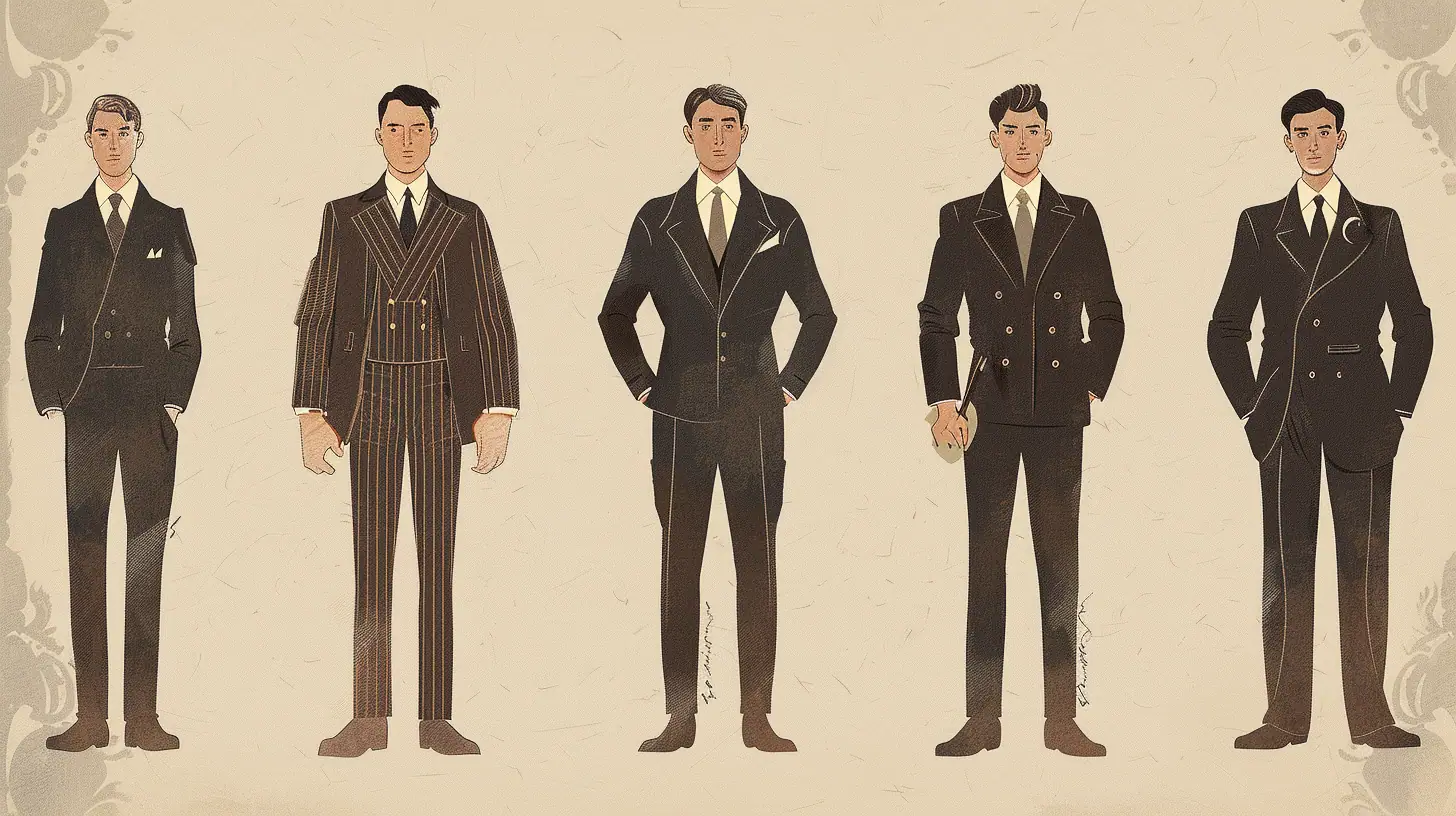
Evolution of men’s suits tells a fascinating story of social change and shifting power dynamics throughout history. You’ll find that suit origins can be traced back to the European courts, where tailoring techniques evolved to create more form-fitting garments that showcased power and status.
The fashion evolution of suits mirrors significant historical context, from the elaborate court dress of the 17th century to today’s streamlined business attire. You’ll notice how societal influences shaped the way suits developed, reflecting changing gender norms and cultural significance across different eras.
| Era | Suit Materials | Cultural Impact |
| 1600s | Silk, Brocade | Royal Court Status |
| 1700s | Wool, Velvet | Aristocratic Power |
| 1800s | Cotton, Tweed | Industrial Success |
| 1900s | Synthetic Blends | Business Authority |
| 2000s | Tech Fabrics | Professional Identity |
Throughout the centuries, you’ll see how suit materials evolved from luxurious silks to practical wools, and now to modern performance fabrics. The cultural significance of suits has remained constant, though their meaning has shifted from royal court attire to symbols of business success.
When you look at today’s suits, you’re seeing the culmination of centuries of tailoring techniques and design evolution. What started as a symbol of aristocratic privilege has transformed into a universal symbol of professionalism and sophistication, crossing cultural boundaries while maintaining its power to enhance the male silhouette.
Building on suits’ historical power to command respect, proper posture and body language multiply their impact dramatically. When you wear a suit, you’ll naturally find yourself standing taller and moving more deliberately, as the garment’s structure encourages better alignment of your spine and shoulders.
These posture effects aren’t just physical – they create a psychological boost that enhances your presence in any room. Your suit becomes a powerful tool for projecting confidence through body language nuances. You’ll notice that the suit’s construction naturally guides your movements, making them more refined and purposeful.
The jacket’s shoulders create a frame that makes crossing your arms look more authoritative, while the tailored fit encourages you to keep your chest open and head high.
To maximize your suit’s impact through body language, focus on these key elements:
The combination of proper posture and confident body language transforms how others perceive you in a suit. The garment’s clean lines and structured silhouette amplify these nonverbal cues, creating an impression of authority and competence.
Through centuries of tailoring evolution, symmetry has remained a cornerstone of suit design that instantly draws the eye and projects authority. When you put on a well-tailored suit, you’ll notice how the balanced proportions create a harmonious visual effect that’s both pleasing and commanding.
The symmetrical patterns in suit design work to enhance your natural body structure. You’ll find that the lapels mirror each other perfectly, while the shoulders align to create a balanced frame. The placement of buttons, pockets, and vents follows precise mathematical proportions that have been refined over generations of tailoring expertise.
The design aesthetics of a suit rely heavily on bilateral symmetry, meaning the left side matches the right. This symmetry extends beyond just the visible elements – it’s built into the very construction of the garment. When you examine the internal canvas, padding, and stitching, you’ll discover they’re all carefully balanced to create a unified whole.
You’ll notice this symmetrical approach particularly in the suit jacket’s front panels, where the buttons and buttonholes align perfectly with their corresponding elements. Even the placement of the breast pocket and lower pockets adheres to strict proportional rules.
This careful attention to symmetry isn’t just about looking good – it’s about creating a silhouette that your brain naturally interprets as powerful and trustworthy. It’s why a well-cut suit can instantly transform your appearance and make you appear more commanding and professional.

Since ancient times, suits have served as powerful indicators of social standing and professional success. When you put on a well-tailored suit, you’re participating in a centuries-old tradition that instantly communicates your position within the social hierarchy. The suit’s cultural significance extends beyond mere clothing – it’s a visual representation of power dynamics and class distinction that continues to influence how others perceive you.
Your choice of professional attire sends clear visual cues about your status and intentions. Research shows that perception shifts dramatically when you’re wearing a suit, as people tend to associate formal wear with:
In modern society, suits remain powerful status symbols that transcend traditional gender norms. You’ll notice that societal expectations still place significant emphasis on formal attire in professional settings, particularly in industries like finance, law, and corporate management.
When you enter a room wearing a well-fitted suit, you’re not just dressed appropriately – you’re signaling your understanding of and compliance with established professional codes.
The suit’s role in establishing class distinction hasn’t diminished despite casual workplace trends. Instead, it’s evolved to become a situational marker of authority and respect.
You’ll find that wearing a suit still commands attention and respect in contexts where power dynamics matter, from job interviews to business negotiations.
A well-tailored suit works in harmony with a man’s physique to create visual balance and proportion. When you invest in bespoke options, you’re not just buying clothes; you’re crafting a silhouette that enhances your natural features while minimizing any perceived flaws. The psychology behind proper fit adjustments lies in how they affect both the wearer’s confidence and others’ perceptions.
Your fabric selection plays an essential role in how the suit drapes and moves with your body. When you choose materials that complement your build and lifestyle, you’ll find greater style versatility in your wardrobe. The right fit can make you appear taller, slimmer, or more athletic, depending on your goals and the silhouette importance you prioritize.
Understanding seasonal trends helps you make informed decisions about color combinations and textile weights, but don’t let them override your personal style. A well-fitted suit should reflect your individuality while maintaining professional standards for occasion appropriateness.
You’ll notice that proper tailoring influences how you carry yourself – shoulders back, chest lifted, and stride confident.
The psychological impact of wearing a perfectly fitted suit extends beyond mere fashion statements. When your clothing fits properly, you’re less likely to fidget or feel self-conscious, allowing you to focus on more important matters.
Remember that fit isn’t just about comfort; it’s about creating a visual harmony that makes you feel as good as you look. The right tailoring can transform an ordinary suit into a powerful tool for self-expression and professional success.
Strength and power emerge naturally when a suit’s cut strategically emphasizes masculine features. The structured shoulders, defined waistline, and clean lines work together to enhance your natural frame, creating an image of authority and confidence. When you wear a well-designed suit, it instantly amplifies masculine aesthetics through its architectural elements.
Your suit’s ability to enhance masculine features relies on three key design principles:
The transformative power of suit symbolism extends beyond mere clothing – it’s a visual language that speaks to deeply ingrained social perceptions of masculinity.
You’ll notice how the suit’s structured elements work to emphasize traditionally masculine traits: strength in the shoulders, discipline in the clean lines, and authority in the overall silhouette.
The suit becomes a tool for frame enhancement, allowing you to project confidence through its architectural design. Whether you’re naturally broad-shouldered or lean, the suit’s cut adapts to highlight your best features while maintaining a distinctly masculine presence.

Throughout history, suits have shaped society’s perception of power, success, and professionalism. When you wear a suit, you’re not just putting on clothing – you’re tapping into centuries of suit symbolism that spans cultures and continents. From boardrooms in New York to government offices in Tokyo, the suit remains a universal symbol of authority and competence.
You’ll find that the cultural significance of suits extends far beyond the professional domain. In many societies, suits mark life’s most important moments: weddings, graduations, religious ceremonies, and formal celebrations. They’ve become so deeply embedded in our cultural consciousness that you’ll often see them used in media and advertising to convey trustworthiness, sophistication, and achievement.
The suit’s influence on popular culture can’t be understated. When you think of iconic figures like James Bond or Wall Street executives, the suit is an integral part of their identity. It’s transformed from mere clothing into a powerful visual shorthand for success.
In many Asian cultures, you’ll notice the suit has been adopted and adapted, blending Western influence with local traditions to create unique expressions of professional dress.
You’re participating in this rich cultural legacy every time you put on a suit. Whether you’re attending a job interview or walking down the aisle, the suit communicates your respect for the occasion and your understanding of social protocols.
It’s a reminder that some cultural symbols transcend time and borders, maintaining their power to influence how we’re perceived and received in society.
The evolution of modern suits traces back to surprising origins you mightn’t expect. Historical significance points to ancient Rome, where togas served as the first formal dress codes for men of status.
You’ll find that suit symbolism emerged during the Renaissance, when tailoring techniques advanced and clothing became a clear marker of social standing.
During the 1800s, fashion evolution took a dramatic turn as societal norms shifted. You’re wearing the legacy of Beau Brummell, who revolutionized men’s fashion by introducing the basic elements of today’s suit. His influence on style icons and cultural variations continues to shape modern menswear.
The transformation of suits through time reveals three key developments:
Today’s suit represents centuries of refinement in both design and social meaning.
You’re participating in a tradition that’s continuously adapted to changing times while maintaining its core appeal. Modern tailoring techniques allow for better fit and comfort than ever before, while dress codes have become more flexible.
Yet despite these changes, the suit’s power to transform appearance and convey authority remains constant, bridging ancient traditions with contemporary style.
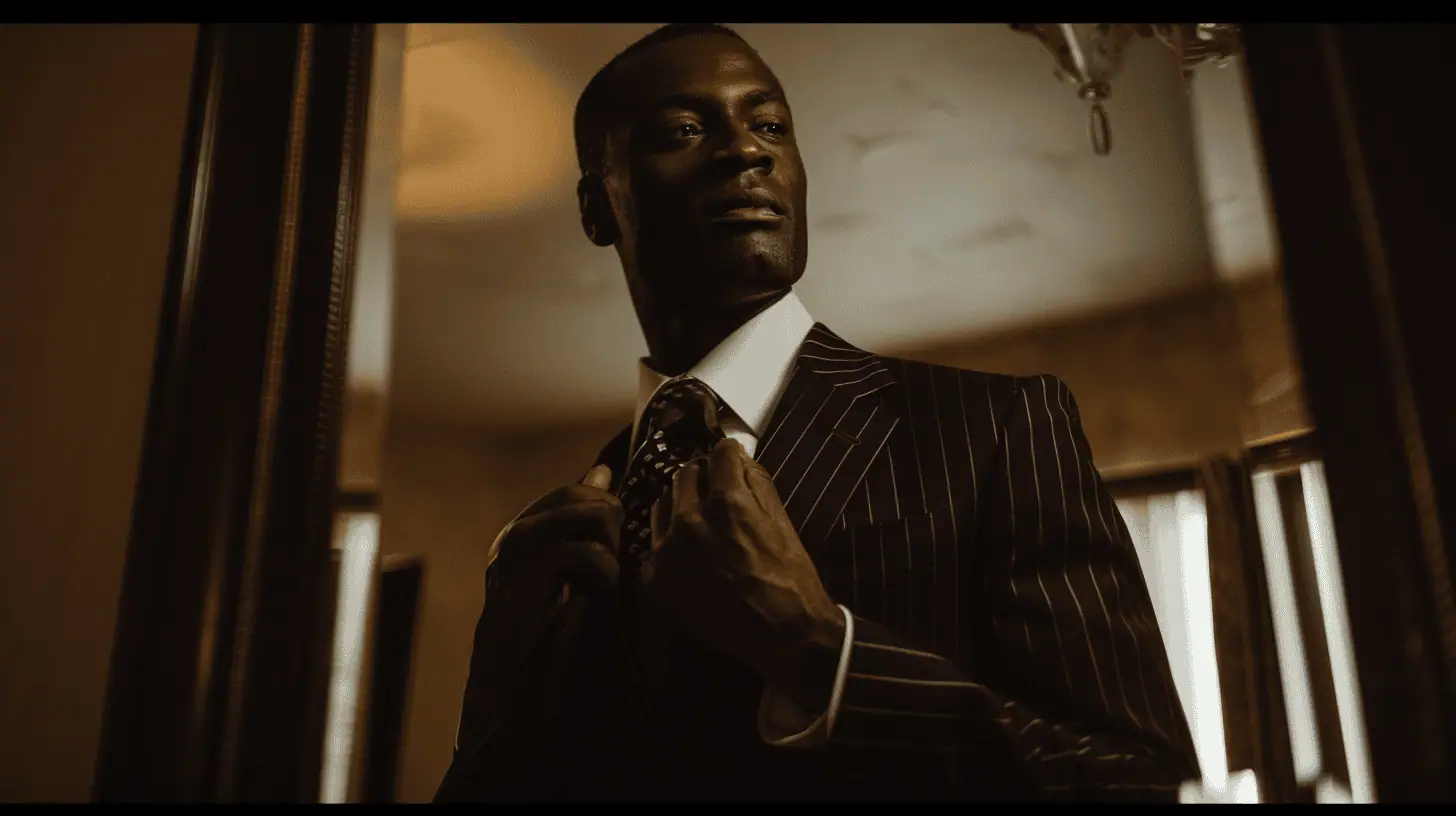
When you slip on a well-fitted suit, your posture naturally improves and your demeanor shifts. The transformative power of a suit provides an immediate self image boost, affecting how you carry yourself and interact with others.
You’ll notice your shoulders pull back, your chin lifts slightly, and you begin to embody the confidence that professional appearance naturally commands.
Your fashion choices in suiting directly impact your confidence enhancement and emotional impact in social situations. When you’re wearing a suit that fits perfectly and matches your personal style, you’ll find yourself more engaged in social interaction, speaking with greater authority, and feeling more self-assured in professional settings.
This isn’t just about looking good – it’s about how the suit becomes an extension of your identity expression.
The relationship between suits and self presentation goes beyond mere aesthetics. You’re likely to experience improved body positivity when wearing a well-tailored suit, as it emphasizes your best features while creating clean, flattering lines.
Your suit becomes armor that helps you navigate challenging situations, from job interviews to important presentations. It’s a tool for self-expression that allows you to control how others perceive you while reinforcing your own sense of capability.
For ideal suit maintenance tips, you’ll want to dry clean your suit every 3-4 wearings or when it’s visibly soiled.
However, don’t over-clean, as excessive dry cleaning can damage the fabric.
Between cleanings, you can maintain your suit’s fabric care by hanging it on a quality hanger, brushing it after wear, and letting it air out for 24 hours before storing.
Steam cleaning at home can help refresh your suit between professional cleanings.
Like having a glitchy smartphone, your body can react unexpectedly to suit fabrics.
You’ll mostly encounter suit fabric allergies if you’re sensitive to wool, synthetic materials, or chemical treatments used in manufacturing.
If you’ve got skin sensitivity concerns, you’re not alone.
You can prevent reactions by choosing natural, breathable fabrics like cotton or linen, wearing a protective undershirt, and ensuring your suits are properly cleaned of residual chemicals.
You’ll get 3-5 years of regular wear from a well-maintained suit, but quality suit materials and proper suit care can extend this to 10+ years.
To maximize lifespan, you’ll want to rotate between multiple suits, use proper hangers, dry clean sparingly, and brush after each wear.
If you’re storing your suit, keep it in a breathable garment bag and avoid plastic covers that can trap moisture.
Like a fingerprint’s unique pattern, your suit’s alterations tell a story.
You’ll find that minor tweaks to achieve the perfect suit fit typically won’t dent a designer brand’s resale value – they might even enhance it.
However, if you’ve made major structural changes like shortening the jacket markedly or altering the shoulders, you’ll see the value drop.
Smart alterations that respect the original design will keep your investment intact.
You shouldn’t store suits in plastic dry-cleaning covers long-term, as they can trap moisture and potentially damage the fabric.
For proper suit care, use breathable garment bags made of cotton or canvas instead. While plastic covers offer temporary fabric protection during transport from the cleaners, they’re not ideal for closet storage.
Hang your suits on quality wooden hangers and guarantee they’ve enough space to prevent wrinkles and maintain their shape.
Haven’t you noticed how a well-fitted suit transforms any man’s appearance? By combining structured shoulders, balanced proportions, and clean vertical lines, suits enhance the masculine frame while projecting confidence and authority. Whether you’re heading to a business meeting or special occasion, you’ll find that a suit’s timeless appeal continues to influence modern fashion, making it an essential wardrobe piece that’ll always make you look and feel your best.



